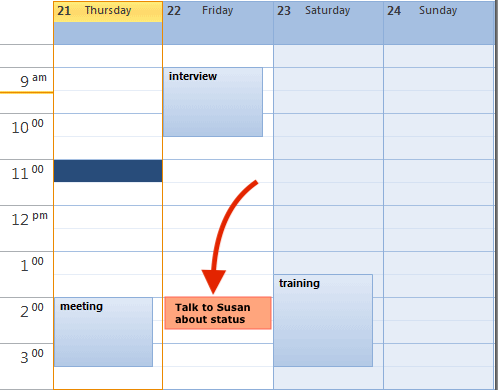Back in the days when I was a kid, we used to travel a lot with my family. One year we spent our vacation with friends in the UK.
I remember this trip very well due to one reason: On the day we headed back to Germany, we left one important item in the fridge.
What was it?
The night before departure my mum had prepared some meal for the journey. It was going to be a 12 hour ride by car. So we needed quite a bit of food.
But unfortunately, we forgot THIS in the fridge:

Not good when you’re traveling for so many hours!
Anyway, to cut the story short: My mother forgot to care of one very important action: To put the meatballs in the portable cooler. Fortunately, we still had enough food on the journey. And I didn’t starve (otherwise you wouldn’t read this here).
With project-related action items, it is just the same.
If you forget just one important item you may run into a problems later.
As it is such an important topic I thought it would help you if I shared my thoughts and best practices around the topic.
What are action items in project management?
Action items are all the things you and your team need to do.
In our definition we shouldn’t just limit ourselves to “work items” like building a software or designing a machine. As a project manager you’ll have a lot more things under your supervision.
Here are some examples of action items:
- Book a conference room
- Clarify date for the next steering board meeting
- Order food for a team workshop
- Notify our supplier of our ongoing project
- Have a discussion with the supervisor of one of your team mates
You can see that I call everything an action item that somehow needs to get done.
Action items are the backbone of any project.
You must ensure that none of the items gets forgotten. If it does, bad things will happen. Starting from your team getting upset because you forgot to order food for a workshop. And up to a big logistical because you forgot to notify your suppliers about the impact of your project on the supply chain.
We don’t want that to happen, ok?
How can you ensure that no action item falls through the cracks?
Rule #1: Create a system for tracking action items
This is your way of recording and updating actions. You don’t have to use fancy software for this. If you prefer to work with a sheet of paper, that’s totally fine. What really matters it that you are using the system consistently.
Personally, I use a very simple tracking method: I have an Excel sheet that includes the item description, a due date, a responsible, the item status plus some a few extra fields. Here’s a screenshot of my tracking sheet:

DOWNLOAD MY ACTION TRACKING TEMPLATE
Rule #2: Record new action items immediately
If you’ve ever been in a time-critical project, you know that new action items can pop up any minute and in any situation:
- On the way back from lunch, your colleague informs you that he’s unable to install the new software. Some incompatibility issue. Damn! You make a note: “organize crisis meeting with server team” and “reschedule system test”.
- Back at your desk you have one missed call. It’s the supervisor from the department next door. Upon calling back you learn that Jim (one of his team members) got the flu and won’t be back in the office before end of next week. Sorry for Jim, and sorry for you: This is going to impact your project. Jim is a key resource and you can’t wait til end of next week! You record a new action item: “see how can do Jim’s development work”.
- While having a pee you have a conversation with your friend and co-worker Tom. He’s really upset about a new change in corporate policy . “They are making the process so complicated! It took us two extra weeks to get the paperwork done!”. You haven’t heard about this change before. Being a fast thinker, you immediately realize this might mess up your planning. New action item: “check impact of new corporate policy”.
Do you realize how overwhelming this can be?
Just by walking around you are being bombarded with a TON of new information. You need to process everything and decide on what to do. Trying to memorize all the news won’t work, even if you have the memory of an elephant. And the risk of missing one item is just too high.
That’s why you should record new action items immediately.
If you are not at your desk, use a piece of paper and enter it into your to-do list later.

Being very diligent with tracking action items and acting upon them will spare you a lot of pain.
Rule #3: Be consistent with follow up
Next, you need to systematically follow up with the people who are doing the work. The team members who you’ve named as responsible behind each action item.
I go through the action items list every day. For super-critical tasks I even put a reminder in my calendar.
For example, if Susan has been tasked to take care of a job, I’ll put a reminder in my calendar and call up Susan when I get an alert from Outlook:

Also read about what to do if your team members don’t meet deadlines.
Watch out for complementary action items
Project action items are like pieces in a puzzle: They are interrelated. One piece is missing? Well, you can’t assemble the whole puzzle then.
The thing is: you may not be aware of all action items in the first place. You put your energy into completing one job, assuming that it’s all that must be taken care of. Then you realize that there’s actually a whole chain of other related or complementary action items that must be completed before the project can move on.
Examples:
- You are organizing a 3-day workshop. Complementary action items could be: book accommodation for the attendants, order food and beverages, reserve a conference room, preparing a presentation.
- As part of your project a letter has to be sent out to your company’s customers. The letter has to be approved by the CEO and by corporate communications (these are complementary action items).
- An external team of IT consultants is supporting your project. You need to get access cards for the guys so that they are able to get into the office. Put down “get access cards for external staff” as an additional action item.
Be systematic and consistent
A big part of your success in project management depends on just two factors: 1) Having a system for tracking action items and using it consistently. 2) Being confident in delegating work and running follow-ups in a consistent manner.
Author
-
Hi, I’m Adrian, a Senior Project Manager and the Creator of Tactical Project Manager, where I teach a pragmatic approach to project management. Led large-scale IT and business projects for over 10 years. My goal is to enable you to lead any project with confidence.
View all posts



